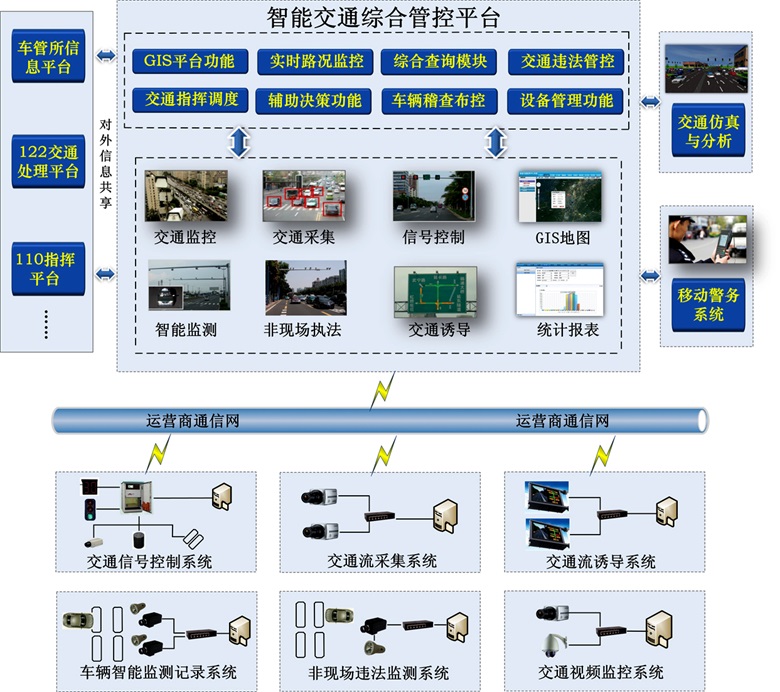
Smart Rail Transit

Urban rail transit includes subways, light rails, trams, maglev trains and many more. The urban rail transit intelligent system includes integrated monitoring system, passenger information system, integrated security system, communication system, automatic ticket checking system and signal system.
First, integrated monitoring system
is a large computer integration system based on modern computer technology, network technology, automation technology and information technology. The system integrates and interconnects several subway automation professional subsystems, mainly integrating environment and equipment monitoring systems, power monitoring systems, automatic fire alarm systems, and interconnecting with other subsystems. Under the support of the integrated platform, the unified monitoring of each major is carried out to realize the information sharing of each professional system and the linkage control function between the systems, improve the operational efficiency, and provide an information foundation for realizing the modern operation and management of urban rail transit.
Second, comprehensive security system
Generally consists of security network subsystem, security integrated management subsystem, integrated TV monitoring subsystem, access control subsystem, electronic wall system and station emergency alarm subsystem. Realize the functions of access management, registration, real-time video surveillance and intrusion detection for stations, depots, parking lots, main substation equipment and management rooms, entrances and exits, ticket offices, banks and other key areas to effectively protect subway operations. . The integrated security system and the integrated monitoring system are interconnected at the central level and the station level, and receive the mode control information of the integrated monitoring system. The integrated monitoring system coordinates the linkage between the integrated security system and the fire alarm system and equipment environmental monitoring system.
Three, passenger information system
Under normal circumstances, it can provide real-time multimedia information such as train time information, government announcements, travel references, stock information, media information, advertisements, etc.; in fire and blockage, terrorist attacks Provide dynamic emergency evacuation instructions, etc. Fully improve the overall service level and quality of subway or light rail operations.
Four, automatic ticket checking system
referred to as AFC system, is a ticket management mode widely used in the world subway / light rail. The automatic ticket checking system (AFC system) adopts a fully enclosed operation mode, as well as a metering and timing charging mode. Using a non-contact IC card as the ticket media, the ticket sales, ticketing, billing, charging, statistics and other ticketing operations in the subway/light rail operation are completed through a highly secure, reliable, and confidential automatic ticketing computer network system. Process, multitasking automated management.
V. Communication System
Generally consists of subsystems such as transmission network, official telephone, dedicated telephone, radio, wireless communication, clock, power supply and grounding, which constitute various voice, data and images. Integrated business communication network for information. Under normal circumstances, the communication system transmits voice, data, images and other information for operations management, traffic scheduling, equipment monitoring, fire alarm and other systems. In abnormal and emergency situations, the communication system also serves as a means of communication for disaster relief.
Six, Signal System
is the key system equipment to ensure the safety of train operation, modernize the traffic command and train operation, and improve transportation efficiency. The urban rail transit signal system usually consists of the train automatic control system (ATC). The ATC system consists of four subsystems: the train automatic monitoring system (ATS), the train automatic protection subsystem (ATP), the train automatic operation system (ATO), and the computer. Chain system (CI). The subsystem forms a closed-loop system through the information exchange network, realizes the combination of ground control and on-board control, and combines local control with central control to form a safety equipment-based, integrated driving command, operation adjustment and train driving automation. Train automatic control system.
The advantages of the urban track intelligence system:
First, high-tech aspects
Using advanced computer network technology to achieve automatic tracking and management of trains and vehicles to improve transportation efficiency and better communicate with railway users to improve transportation services. The advanced information transmission technology is adopted to replace the traditional track circuit, which can meet the needs of efficient and large-capacity information transmission between the dispatch center and the train group. Using advanced train positioning and speed measurement technology, the precise position and state of the train can be determined.
Second, smart aspects
Transformed from traditional control and management to knowledge engineering, capable of simulating human behavior to implement management of trains and trains. The former is an intelligent train, which realizes train assist and automatic driving through a vehicle-mounted microcomputer, and the latter completes functions such as driving plan, operation management and information service through the dispatch center intelligent workstation.
Three, integrated integration
In recent years, with the advancement of science and technology and the development of computer integration technology, it is possible to integrate multiple professional subsystems through a unified platform. In the current large-scale construction of urban rail transit in China, through the unified software and hardware platform provided by the integrated integrated system, the monitoring information of the central dispatchers and the station duty personnel will be brought together under the support of a powerful integrated software development platform. The end user can conveniently and effectively monitor and manage the operation of the professional subsystem of the entire line through a graphical human-machine interface. And achieve information sharing and coordination between systems.
